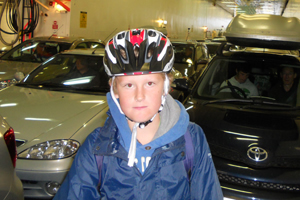


Getting ready for training Tom ran out onto the school pitch and began to warm up with his team mates. It was October 5th 2010 and Tom Tapp was taking part in a practice rugby match at his Ludlow school.
The 11 year old was a pupil at Moor Park and the match had started as normal. Despite rugby being a heavy contact sport, Tom had played for four years prior to that day and other than the odd cut or bruise; he hadn’t suffered any major injuries through his love for the physical sport.
However on that day, Tom was the ball carrier and as the game began the team formed a ruck (loose play). It was during this that Tom folded his body over and his upper body crunched forward.
As his other team mates broke off to continue the game, Tom fell to the ground in pain. His head master realised immediately the possible severity of his injuries and called for an ambulance.
When the land ambulance arrived, Tom was quickly assessed by the crew who realised he could have severe spinal damage. However the true extent of Tom’s spinal injuries could not be determined on the pitch and while he had no visible breaks to limbs or any bleeding the air ambulance was required to transport him to hospital to minimise the risk of causing further spinal damage.
Within minutes the Midlands Air Ambulance had landed on the school playing field and Tom was being airlifted off the school pitch.
It took air crew just seven minutes to transfer Tom to hospital and he remained conscious whilst airborne. Crew needed to ensure he remained still throughout the flight and so he was placed on the spinal board and had padded head restraints placed on each side of his head to keep him stable, while crew continued to assess him for other injuries.
En Route the hospital was briefed and ready for Tom. It was not be until Tom arrived at the hospital that a CT scan showed just how lucky he had been.
His father Andrew Tapp is a doctor at Royal Shrewsbury Hospital where his son was airlifted to.
His father explains what happened next; “I met paramedics on the Heli pad and was informed of my son’s accident and possible injuries. The air crew were incredible with him.”
His father’s concern grew when the first x-ray showed that Tom had broken one or more of his vertebrae. Tom was kept on a spinal bed that evening and the following day doctors gave him a CT scan to look closer at his spine.
Thankfully this x-ray showed that he had only ‘squashed’ two vertebrae. This form of fracture is known as a ‘stable fracture’ and luckily required no further treatment. The damage would heal itself and Tom took just a week off school before returning to his studies and while he didn’t play rugby for the rest of the academic year, when the new season started Tom was back on the pitch and rearing to go.
His accident has certainly not put him off his favourite sport and luckily Tom will have no lasting injuries.
The medical team acknowledged that if Tom had made the 20 minute journey by land ambulance, there was a distinct possibility that his injuries could have been aggravated leading to more serious complications.
Soon after the accident Tom decided he wanted to raise money for the charity. He was determined to say thank you and with the help of his father they tailor made their own fundraising challenge.
The pair created a bike ride and named it ‘The Five Island Challenge’ and in August 2011 the duo set off to Scotland to complete their unique task.
The father and son team started in Mallaig in Scotland and then took a ferry to Skye. The pair then biked for five days across various islands, totalling 160 miles and raised a fantastic £1500 for the charity
Andrew said; “We decide to create or own route because we both like Scotland, it’s a different place to go, and not many cars!”
Tom, now 12 said; “I wanted to thank the people who looked after me and do something different to catch people’s attention. I wanted to help raise as much money as I could and give something back to the charity. Thank you!”